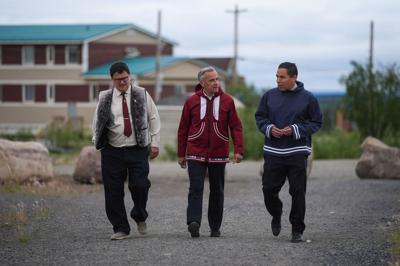OTTAWA — Prime Minister Mark Carney appointed Nunavut’s Virginia Mearns as Canada’s first Arctic ambassador on Thursday, as his Liberal government seeks to strengthen ties between Ottawa and the country’s north at a time of increased geopolitical instability.
Carney made the announcement behind closed doors after kicking off a summit with Inuit leadership in Inuvik, N.W.T., that focused on the implementation of Ottawa’s controversial major projects law.
“There are new threats that have emerged, physical threats, virtual threats, tangible threats,” the prime minister said alongside eight members of his cabinet.
“We take those threats seriously, we take our responsibility to defend all Canadians seriously. It’s the first thing we think about when we get up in the morning.”
Mearns is senior director of Inuit relations for the Qikiqtani Inuit Association, an organization that represents more than half of Inuit living in the Canadian Arctic. She has held a number of roles within the Nunavut government, including in intergovernmental affairs.
Her new position was created under former prime minister Justin Trudeau’s government, when then-foreign affairs minister MĂ©lanie Joly unveiled a new Arctic foreign policy plan in December.
The plan notes that the position was established “to ensure that the Canadian Arctic remains a region that is stable, prosperous and secure,” to advance Canada’s polar interests, to work with Arctic and non-Arctic states, and to raise the profile of Indigenous rights in the region. The Prime Minister’s Office said Mearns will start in the role Sept. 15, with a mandate to strengthen Arctic sovereignty.
Arctic security was only part of Thursday’s wide-ranging agenda.
Inuit Tapiriit Kanatami president Natan Obed, who is co-chairing the meeting of the Inuit-Crown Partnership Committee with Carney, said Thursday that he also planned to raise key priorities like supports for children, the housing crisis in the north, and the need for essential community infrastructure.
“We come, as Inuit, understanding that the government of Canada will always have priorities, and the Inuit will always have priorities. Where we meet in the middle is where we can do the best work,” Obed told Carney.
The primary reason for Thursday’s summit, however, was the Building Canada Act, part of a contentious law known, prior to its passage, as Bill C-5. The legislation was introduced to respond to Canada’s trade dispute with the United States, and was rushed through Parliament in June. It grants Ottawa temporary powers to sidestep environmental laws and regulations to fast-track “nation-building” projects like pipelines, ports and mines.
The law, and its hasty introduction, prompted criticism that it was putting Indigenous rights and environmental protections at risk.
“Really, what the act does is it creates conditions for the federal government to be more effective and efficient in our part of the partnership,” Carney said.
“For too long the attitude in Ottawa has been, ‘Why should a project be done?’ as opposed to …‘How do we help the project to move forward?’”
Thursday’s gathering was the prime minister’s second of three such meetings. Last week, he met with hundreds of First Nations leaders in Ottawa to air out grievances and chart a path forward after the law’s passage.
Carney suggested at that meeting that he was focused on implementing the law in partnership with First Nations rather than amending it, and pledged to participate in further regional consultations. While some chiefs left the confab expressing cautious optimism about the closed-door discussions, others left the summit early, believing the federal government’s attempts at consultations were hollow and flawed.
Carney is set to meet with MĂ©tis leadership at a later date.
Error! Sorry, there was an error processing your request.
There was a problem with the recaptcha. Please try again.
You may unsubscribe at any time. By signing up, you agree to our and . This site is protected by reCAPTCHA and the Google and apply.
Want more of the latest from us? Sign up for more at our newsletter page.



























To join the conversation set a first and last name in your user profile.
Sign in or register for free to join the Conversation